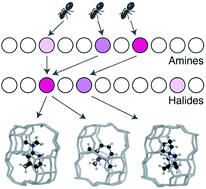Multi-objective de novo molecular design of organic structure-directing agents for zeolites using nature-inspired ant colony optimization†
Abstract
Organic structure-directing agents (OSDAs) are often employed for synthesis of zeolites with desired frameworks. A priori prediction of such OSDAs has mainly relied on the interaction energies between OSDAs and zeolite frameworks, without cost considerations. For practical purposes, the cost of OSDAs becomes a critical issue. Therefore, the development of a computational de novo prediction methodology that can speed up the trial-and-error cycle in the search for less expensive OSDAs is desired. This study utilized a nature-inspired ant colony optimization method to predict physicochemically and/or economically preferable OSDAs, while also taking molecular similarity and heuristics of zeolite synthesis into consideration. The prediction results included experimentally known OSDAs, candidates having structures closely related to known OSDAs, and novel ones, suggesting the applicability of this approach.



 Please wait while we load your content...
Please wait while we load your content...